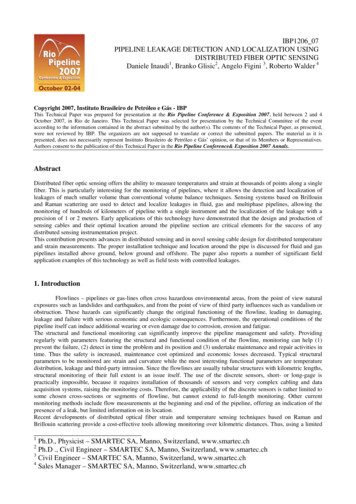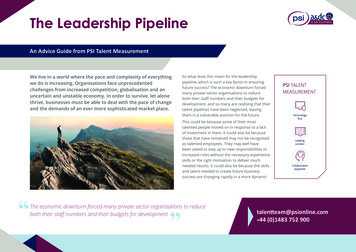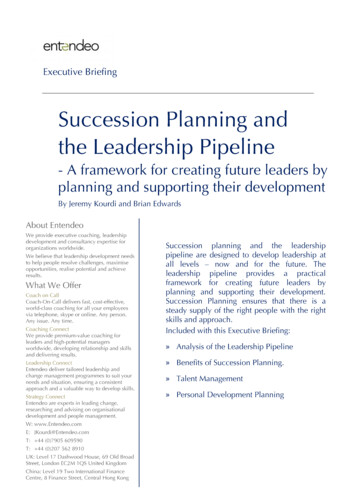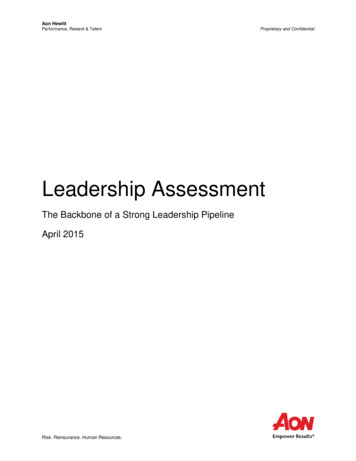
Transcription
The School Leadership Pipeline Series:Promising Leadership for School Turnarounds2PARTBy Kim Knous Dolan
THE SCHOOL LEADERSHIP PIPELINE SERIES: Part 2Table of ContentsRecognizing the central role that school leadership plays in advancing student achievement,the Donnell-Kay Foundation conducted a survey of Colorado’s superintendents and leadersof Colorado’s charter management organizations (CMOs) to better understand the schoolleadership landscape in our state. The goal of this project is to inform ongoing state anddistrict efforts to build a robust human capital pipeline to educate our state’s students. Basedon the results of the survey and subsequent research, the Donnell-Kay Foundation is releasinga series of policy papers examining Colorado’s school leadership pipeline.Overview.3Key Survey Findings. 4Promising Research and Trends.5 Hiring the Right Leaders.5 Leadership Preparation and Pipeline. 7 Conditions for Success. 8 District Support. 8 Leadership Teams. 9 Incentives. 11Recommendations. 12Conclusion. 142
THE SCHOOL LEADERSHIP PIPELINE SERIES: Part 2OverviewOVERVIEW OFCOLORADO’STURNAROUNDSCHOOLS, 20124In the fall of 2012, the Donnell-Kay Foundation conducted asurvey of Colorado’s superintendents and charter managementorganization (CMO) leaders to understand the pipelinechallenges faced by district and charter leaders in the state.The results of the survey found particular challenges withrecruiting, supporting, and retaining qualified leaders for schoolturnarounds.1 In light of these responses, this paper examinesthe promising research and national trends specific to schoolturnarounds.In recent years, Colorado has struggled to successfullyturnaround its lowest performing schools (see side bar).Despite some signs of short term success around the nationand in a few areas in Colorado,2 large scale school turnaroundefforts have largely fallen short.3Increased accountability policies at both the state and federallevel and additional resources, including a 51 million influx offederal dollars for School Improvement Grants (SIG), appearto have little effect with regard to progress of large scale schoolturnaround efforts.Out of Colorado’snearly 1,800 schools,51 were assignedSchool TurnaroundPlans.10 schools,2 districts, and 1Board of CooperativeEducational Services(BOCES) are currentlyeligible forstate-mandatedturnaroundinterventions becausethey have failed tomake substantialprogress under currentimprovement plans.The state estimatesthat 25-30 schoolsand 8-10 more districtswill likely be assignedturnaround plans forseveral years, andtherefore will beeligible forrestructuring.School turnarounds are the lowest performing schools in the state according to the state’s primary accountability tool, the District and School Performance Framework(DPF/SPF) report.2 Colorado Turnaround Schools - Rays of Hope. A Denver Report, 2012.3 Smarick, Andy. The Turnaround Fallacy: Stop Trying to Fix Failing Schools. Close them and Start Fresh. Education Next. Winter 2010. Volume 10, No. 1.4 Baker, Robin, PhD; Hill, Paul, PhD; Hupfeld, Kelly, JD; and Paul Teske, PhD. Turnarounds in Colorado: Partnering for Innovation Reform in a Local Control State.February 2013.1 3
THE SCHOOL LEADERSHIP PIPELINE SERIES: Part 2Key Survey FindingsSurvey Data:Shortage of Qualified Principals to Lead School Turnaround Efforts. Survey respondentscited a shortage of quality candidates applying to work in school turnarounds, with about60% of the superintendents and CMO leaders saying this was a problem. This concern overshortages for turnaround leaders is problematic in rural areas (65% reporting a shortage) andis especially acute in urban/suburban areas (with 70% reporting a shortage).5Colorado is Failing to Train Principals to Workin School Turnarounds. There is the perceptionthat current preparation programs are not preparingpeople well for working in school turnarounds. Thisperception is especially strong in urban/suburban districts, with 80% of respondents sayingtraining programs were not preparing principalswell for working in school turnarounds.80%of respondentssay training programs were notpreparing principals well forworking in school turnaroundsPrincipals in Turnaround Schools LackProfessional Development Support.Principals newly appointed to turnaround orpriority improvement schools are least likely tobe identified for professional development support(43% are identified for support). Even when they areidentified as needing help, principals often do notreceive support.Very Few Districts/CMOs Offer Incentives forPerformance. Only 9% of respondents said theyoffered differentiated pay for student achievementgains. However, of the types of schools examined(turnaround, high-poverty, alternative schools,innovation schools) – leaders running schoolturnarounds were most likely to receive sometype of incentive pay for working in this type ofenvironment. This response was strongest inurban/suburban districts.“At the macro level, many individualswith strong leadership potential electnot to pursue a principal's position —especially mid-career and veteranteachers — because the compensationwill be about the same, or in some caseslower, than what they would earn as ateacher. In high-poverty schools and thoseon priority improvement/turnaround, thesechallenges are further exacerbated bythe heightened risk of being fired for notimproving student achievement.”– Survey RespondentNote: survey respondents indicated that finding quality candidates to work in high-poverty schools across the state was the highest ranked reported shortage,with 63% reporting a shortage.5 4
THE SCHOOL LEADERSHIP PIPELINE SERIES: Part 2Promising Research and TrendsHIRING THE RIGHT LEADERSTo successfully lead any school, a competency frameworkis important for identifying the set of skills, knowledge, anddispositions needed to drive student success (see CompetencyFramework Sidebar). In Colorado, the state standards forprincipals can serve as a baseline guide for principal knowledgeand skills, but research indicates that leaders need specificdispositions to be successful.6For school turnaround leaders specifically, research highlightsthat “turnaround school leadership requires a set of attitudesand skills not typically conveyed in traditional preparationprograms or regularly needed in higher-functioning schools.” 9Research from the American Institute of Research (AIR)indicates that successful turnaround leaders must have: Superior instructional leadership Attention to the system Capacity to identify and leverage (at the right time)key points within the system to advocate for anddeliver a well-aligned, well-articulated transformationplan Ability to execute ‘quick wins’ to demonstrate thatthe school is on the path to improvement and buildmomentum for change10Schools in turnaround likely have a history of ineffective adultpractices, so important leader strengths include the ability to“overcome the inertia of previous failures; promote the beliefthat all students can achieve at high levels; manage teacherseffectively by helping them improve their practice; and supporta change management process. If the leader is expected toreplace significant portions of staff, strong interviewing andhiring skills are also critical.” 11IDEAL ASPECTSOF A COMPETENCYFRAMEWORK 7Creates the guiding goalsand provides the structureto coordinate and align allprogrammatic elements,systems, and processes.Guides everything frombuilding a candidate pool,to selecting candidates,to training and developingaspiring leaders, tosupporting new principals.Serves as the keyevaluative tool.PUBLIC IMPACT:TURNAROUNDLEADERCOMPETENCIES8Driving For Results –enable a relentless focuson learning and results Achievement Initiative and Persistence Monitoring andDirectiveness Planning AheadInfluencing for Results–enable working throughand with others Impact and Influence Team Leadership Developing OthersProblem Solving–enable solving and simplifyingcomplex problems Analytical Thinking Conceptual ThinkingConfidence–enable focus and confidence Self ConfidenceSchool Turnaround Leaders: Competencies for Success. Public Impact: June 2008. d Leader Competencies.pdf.A New Approach to Principal Preparation: Innovative Programs Share their Practices and Lessons Learned. Rainwater Charitable Foundation, 2010.Public Impact: d Leader Competencies.pdf.9 Baker, Robin, PhD; Hill, Paul, PhD; Hupfeld, Kelly, PhD; and Paul Teske, PhD. Turnarounds in Colorado: Partnering for Innovation Reform in a Local Control State. February 2013.10 What Experience from the Field Tells Us About School Leadership and Turnaround. American Institutes for Research: A District and School Improvement ThoughtPaper. December 2010.11 Cheney, Gretchen Rhines; Davis, Jacquelyn; Garrett, Kelly; and Jennifer Holleran. A New Approach to Principal Preparation: Innovative Programs Share their Practicesand Lessons Learned. Rainwater Charitable Foundation, 2010.6 7 8 5
THE SCHOOL LEADERSHIP PIPELINE SERIES: Part 2Promising Research and TrendsA key question for those hiring turnaround leaders is: Doesthis principal (either sitting or new) have the skills andcompetencies to initiate a dramatic change effort? “Districtleaders must assess whether the principal has the core skillsand competencies to set ambitious expectations and inspireand influence staff. The principal also needs to be able to leaddisruptive change, rigorously assess and potentially dismisspersonnel, and take risks to create a school culture thatprioritizes high expectations and quality instruction.” Further,“existing and emerging research confirms it is feasible toinitiate and successfully implement changes that will result indramatic improvements in the performance of an organizationwithin 18-24 months.”12Creating a competency framework is also critical for helpingdistricts and CMOs hire the right people for the work. There areseveral resources (see sidebar) on how to organize district systemsand hire for success. To help ensure a strong leadership “fit,”entities both training and hiring leaders must deeply understand: The prospective leaders’ history of successand key competencies The specific school context and demandsof the job The potential benefits to the school from aspecific leadership profile“District leaders mustassess whether theprincipal has the core skillsand competencies to setambitious expectationsand inspire andinfluence staff.”RESOURCES:BEST PRACTICESIN SCHOOLLEADER HIRINGHiring QualitySchool Leaders:“Challenges and EmergingPractices Report,”American Institutesfor Research.13Hiring Effective SchoolTurnaround Principals:UVA, Public Impact,and Partnership forLeadership in Education.14In-Depth Toolkits andTechnical AssistanceAround BestPractices in Hiring:New Leaders forNew Schools15and The NewTeacher Project.16– Lauren Morando Rhim,ResearcherRhim, Lauren Morando. No Time to Lose: Turnaround Leader Performance Assessment. UVA, Partnership for Leadership in Education, and the Center on Innovationand Improvement. Spring 2012.13 Clifford, Matthew. Challenges and Emerging Practices Report. American Institutes for Research 2012.14 Hassel, Emily and Lucy Steiner. Using Competencies to Improve School Turnaround Principal Success; Appendix B: Hiring Effective School Turnaround Principals.UVA, Public Impact and Partnership for Leaders in Education 2011.15 New Leaders for New Schools Urban Excellence Framework: 08/UEF-ConceptMaps1.pdf16 The New Teacher Project. Improved Principal Hiring: Hiring-Final.pdf12 6
THE SCHOOL LEADERSHIP PIPELINE SERIES: Part 2Promising Research and TrendsLEADERSHIP PREPARATION AND PIPELINEIn addition to the competencies and dispositions needed for leaders to transform and improveschools, it is critical to examine what training and support is available for individuals choosingto take on this challenging work. There is limited research available on the quality of principalpreparation in general, let alone specialty training for working specifically in school turnarounds.Given this, it is important to support further research in this area.There are a few training programs showing promise: The University of Virginia School Turnaround Specialist Program requires that wholedistricts (not just schools) apply and send a seven-member team to the Specialist Program —a 2-year program, that draws upon training in both UVA’s education and business schoolsto train turnaround leaders.17 Mastery Schools is a charter management organization that currently operates a networkof ten turnaround schools in Philadelphia. Their turnaround approach integrates solidmanagement and effective educational strategies. Successful turnarounds require highexpectations and high levels of support. As a result, they have achieved impressive resultsaround student growth and achievement.18 Scholar Academics (Philadelphia) and Lead Academy (Nashville), are CMOs that aremaking their primary growth investment in school turnarounds and are training leadersfor this work. Get Smart Schools, is the only known principal preparation program in Colorado that hasrecently begun preparing principals to work as leaders in school turnarounds.19 Get SmartSchools is supporting veteran leaders with a track record of success who are interested inbeing trained to work as school turnaround leaders.The Sheridan School District completed this program and representatives from Adams 14 and Ft. Lupton/Weld 8 are currently going through the program.Mastery Charter School Website: ml.19 Districts may have their own training programs.17 18 7
THE SCHOOL LEADERSHIP PIPELINE SERIES: Part 2Promising Research and TrendsCONDITIONS FOR SUCCESSDistrict Support: For school turnarounds, research suggests thatthe right operating conditions must exist for leaders to have thehighest chance of success. UVA’s national experts on turnaroundsclaim that “two major factors affect turnaround success: thecharacteristics and actions of the turnaround leader, and thesupport for dramatic change that the leader and staff receivefrom the district, state, and/or other governing authority.”20“Two major factors affectturnaround success:the characteristics andactions of the turnaroundleader, and the support fordramatic change that theleader and staff receivefrom the district, state,and/or other governingauthority.”Mass Insight – a national non-profit specializing in schoolturnaround work – has produced a research framework thatencompasses nine strategies to illustrate how high-performing,high-poverty (HPHP) schools work best. One of these ninestrategies, “resource authority,” asserts that school leaders needthe ability to make mission driven decisions regarding people,time, money, and program.21Ensuring school leaders have both district support, and theability to operate with flexibility is paramount. Further examination from the American Institutes for Research indicates that“schools in crisis need support to build school-based capacity topermanently transform their learning culture and work conditions.The district can play an important role in developing a criticalmass of high-performing teacher teams, school leadership teams,and networks of schools that contribute to capacity building and,expectedly, sustainability.” 22Hassel, Emily Ayscue and Lucy Steiner. Using Competencies to Improve School Turnaround Principal Success. UVA, Partnership for Leaders in Education andPublic Impact. 2011.21 The Turnaround Challenge Executive Summary: Why America’s Best Opportunity to Dramatically Improve Student Achievement Lies in Our Worst Performing Schools.Mass Insight, 2007.22 What Experience from the Field Tells Us about School Leadership and Turnaround: A District and School Improvement Thought Paper. American Institutes forResearch, December 2010.20 8
THE SCHOOL LEADERSHIP PIPELINE SERIES: Part 2Promising Research and TrendsOpportunity for flexible conditions to exist at the school and district level are made possibleunder Colorado’s Innovation Schools Act of 2008. Innovation schools (and districts) do havemore control and flexibility around people, time, money, and program – making the leadershiprole potentially more desirable.Some examples of effective conditions for success include: Denver Public Schools (DPS) worked with its turnaround partner, BlueprintSchools, to create innovation schools operating with more flexibility in the farnortheast. In 2011-2012, the first year of the far northeast turnaround, most schoolshad high growth ratings. The 2012-2013 data shows a more mixed picture of success.DPS attributes much of the early strong growth scores to its partnership with Blueprint,which focused on excellence in leadership and instruction, increased instructional time,a no-excuses school culture of high expectations, the use of data to improve instruction,daily tutoring in the critical growth years, and greater flexibility to operate. Denver Public Schools (DPS) also recognized the value of using new schools andCMO partners to start new schools as part of its turnaround strategy. Local CMOs suchas KIPP (at Noel) and Strive Prep (at Lake) have opened new schools – one grade at atime – in turnaround schools. These schools are showing signs of promise given theirincreased flexibility to operate and to build a new school culture focused on studentachievement. Louisiana’s Recovery School District (RSD) was created in an effort to turnaroundand re-create many new schools. There are several school improvement strategiesemployed by the RSD, but one key aspect is greater operational flexibility for principals.The 2013 achievement data reveals strong growth scores relative to other Louisiana districts.Leadership Teams: The role of the school leader needs to evolve to meet the demands ofleaders working school turnarounds. The contemporary principal role has grown. Not onlyare principals expected to perform the traditional tasks of ensuring school operations aroundmanaging students, staff and grounds run smoothly, but they are also expected to deeplyengage in instructional and community issues.9
THE SCHOOL LEADERSHIP PIPELINE SERIES: Part 2Promising Research and TrendsMany school leaders burn out quickly and don’t stay in theprincipalship for long. In Colorado, the annual principalturnover rate is one in five, and the annual turnover rate forpriority improvement and turnaround districts is nearly one infour.23 Research shows negative effects of principal turnoveron student achievement, with “frequent turnover of schoolleadership resulting in lower teacher retention and lowerstudent achievement gains. Frequent leadership changes areparticularly disruptive for high poverty and failing schools.” 24There is increased discussion of moving beyond the storyof a single, heroic leader. This is especially important inchallenging school environments such as school turnarounds.At a school turnaround forum examining early success withinthe Summit Schools Network, Assistant Superintendent of DPS,Antwan Wilson said that the notion of identifying a “superstar”principal, putting such a person in place, then simply expecting“magic to happen” is not the answer. “That has played outseveral times in Denver, and not been successful across theboard,” Wilson observed. “There are other conditions that needto be put in place.” 25There is not extensive research or literature on the effectiveness of co-leadership or shared leadership models, for principalsworking in school turnarounds, however, there are a few promisingexamples (see sidebar). The few studies that have looked atdifferent school leadership models found that co-leadershipmodels may reduce the burdens of leadership generally butdon’t necessarily result in more instructional time since themodel requires more time for the leadership team to reachconsensus. The model does “encourage more academic risk-takingand quality decision making, but is largely dependent on thesynergy, shared values, and trust between co-principals.” 26EXAMPLES OFPROMISINGCO-LEADERSHIPSTRUCTURES Roxbury Prep is a chartermiddle school in Massachusettsthat was started in 1999 andhas become one of the topperforming middle schoolsin Boston, serving a highpoverty population. Theschool used a co-directorshipmodel, where one co-leader ledthe curriculum and instructionwork at the school (includingteacher mentoring, coaching,supervision, and evaluation),while the other co-leader wasthe Chief Operating Officer(responsible for data analysis,financial and operationalissues). This school is nowpart of the UncommonSchools Network. Teach Plus is a nationalnon-profit that has severalinitiatives, one of which is aninnovative program (theT3 Initiative) that recruits,develops, and supports cohorts of highly effective andexperienced teachers to helplead turnaround efforts. Havinga critical mass of excellentteachers (along with a qualityleader), has helped change theculture of some of the lowestperforming schools. T3 is nowworking in Massachusetts,Memphis, and D.C. PublicSchools. While specific toteachers, this model could beused for developing effectiveleadership teams. The Denver Green School isa DPS innovation school thatpractices a shared leadershipmodel, with three lead partnerstaking on shared responsibilityfor the main administrativeand educational functionsof the school. Similar to apartnership model in a lawfirm, it is centered on adistributive leadership model.Colorado Department of Education.Beteille, Tara; Kalogrides, Demetra; and Susanna Loeb. Stepping Stones: Principal Career Paths and School Outcomes. Stanford University, March 2011.25 Donnell-Kay Foundation. Policy Forum: Early Lessons from the Far Northeast Turnarounds. Fall 2012.26 Paynter, Susan Ph.D. A Study of the Co-Leadership Model in Charter Schools. Dissertation candidate for Seton Hall University. 2003.23 24 10
THE SCHOOL LEADERSHIP PIPELINE SERIES: Part 2Promising Research and TrendsIncentives: A few larger districts in Colorado(including Denver Public Schools and DouglasCounty Public Schools) offer performance payfor demonstrating academic success (often inhigh-poverty schools), but financial incentives arenot common in Colorado’s school turnarounds.National examples of successful incentiveprograms include: DC Public Schools, through the federalTeacher Incentive Fund (TIF) grant, will beoffering performance raises to principals.All high-performing administrators will beeligible for salary increases of up to 5,000,while those working in the district's40 lowest-performing schools will beeligible for a raise of up to 20,000. The “Strategic Staffing Initiative”in the Charlotte-Mecklenburg,NC School District recruits top principals,with proven track records of success, topick a seven-member teaching andadministrative team to lead a turnaroundeffort. This team receives salary increasesand bonuses in exchange for committing totheir new school for at least three years and toproducing strong student achievement gains.To date, nearly all of the 24 of the participatingschools are on track to successfully beturned around. 27 Teach Plus’ T3 Initiative focuses onturnaround efforts that seek teams of highlyeffective teachers to go into turnaround schools.This is largely done through providing a seriesof incentives such as “leadership opportunities,structured peer learning, and increased pay.” 2827 28 Districts Matter: Cultivating the Principals Urban Schools Need. The Wallace Foundation. February 2013.Sawchuk, Steven. Teacher-Leader Corps Help Turnaround Schools. Ed Week. April 20, 2011.11
THE SCHOOL LEADERSHIP PIPELINE SERIES: Part 2RecommendationsMany of the recommendations made in the first part of the Donnell-Kay Foundation’sSchool Leadership Pipeline Series, Meeting Colorado’s Demand for Excellent Leaders,are applicable to school turnarounds. The following recommendations however, are specific to finding,supporting, and retaining quality leaders to operate in school turnarounds. Information gatheredin the survey, as well as research into national trends and promising practices on schoolleadership for school turnaround, serve as the basis for the report recommendations.STATE1. The Colorado Department of Education (CDE) should plan for staffing needs forschool turnarounds to ensure a pipeline of quality leaders. Provide annual reports to the legislature, districts, schools and the public around itscapacity to support turnaround efforts across the state. The reports should containspecific information, including how many turnarounds leaders Colorado needs now andin the next 3-5 years, as well as specific strategies undertaken by CDE to support therecruitment and training of such leaders.2. The Governor and Legislature should strengthen principal preparation andlicensure for school turnarounds by reducing barriers of entry into the profession fornon-traditional candidates and increasing freedom for principal training programs. Focus less on inputs for principal candidates and more on outputs. Open up theprofession to qualified applicants from all professions and backgrounds, as somecharter schools currently do. Enable and support CDE to reduce regulation and rules around educator preparationprograms and licensing to innovate based on what professionals know works best,with a focus on performance.3. The Legislature and CDE should fund quality partnerships with organizations thatcan provide quality training to leaders for school turnarounds. Invest in high quality leadership training providers with a proven track record of successtraining leaders to work in school turnarounds. Operate or contract out for short-course training for veteran leaders with a proventrack record of success to lead school turnarounds. Support the creation of an elite corps of leaders trained specifically for work in thesechallenging schools. The program should enlist turnaround teams to head successfulturnaround efforts in exchange for higher pay and better working conditions. (e.g.,Charlotte-Mecklenburg Strategic Staffing Initiative and Teach Plus T3 Initiative).12
THE SCHOOL LEADERSHIP PIPELINE SERIES: Part 2Recommendations4. T he Legislature and CDE should provide incentives and conditions to attract thebest leaders and leadership teams to run school turnarounds. Incent districts and school leaders to create more quality innovation schools andfavorable operating conditions. Provide financial and facility incentives to recruit quality CMOs to lead schoolturnarounds, including the elimination of exclusive chartering authority for districtsin turnaround.DISTRICT1. Districts should ensure qualified leaders are working in school turnarounds. Revamp district hiring, evaluation, and support practices to ensure that competenciesand skills – not degrees and experience – serve as the main basis for hiring effectiveleaders for school turnarounds.2. D istricts should provide school
4 THE SCHOOL LEADERSHIP PIPELINE SERIES: Part 2 5 Note: survey respondents indicated that finding quality candidates to work in high-poverty schools across the state was the highest ranked reported shortage, with 63% reporting a shortage. Key Survey Findings Survey Data: Shortage o











